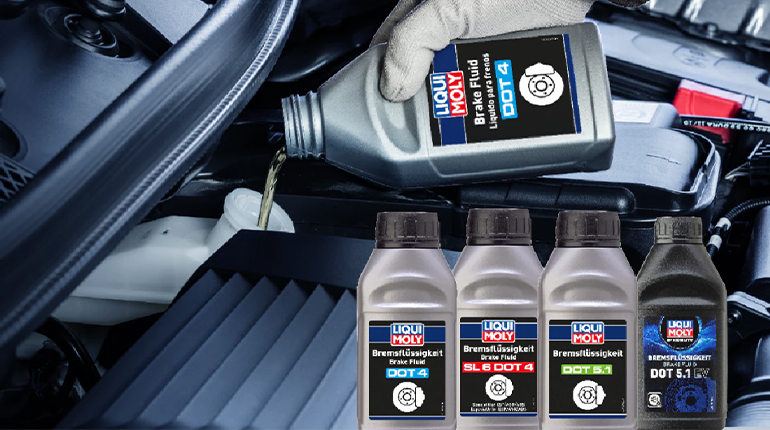
Brake fluid: Function, changing and differences
Whether automobile, vintage car or motorcycle: Brakes are among the most important components in vehicles. In order for them to function properly, they should be protected and maintained. The brake fluid plays an important role in this. High-quality products are essential.
What is brake fluid and what are its tasks?
The brake fluid is a special mixture used in hydraulic brake systems. It plays an important role in road safety. When the brake pedal is depressed, the pressure is transmitted via the brake fluid to the brake cylinders on the brake caliper. These then press the brake pads against the brake disks or drums. This reduces the speed of the vehicle. The brake fluid must withstand extreme conditions. These include high temperatures and pressures.
Ten facts about brake fluids
1. A high boiling point for safety under extreme operating conditions so that the brake fluid does not start to boil prematurely and reduce the braking effect due to the formation of steam bubbles.
2. The so-called boiling point depression caused by the absorption of water into the brake fluid must be kept as low as possible; the main parameter is referred to as the wet boiling point.
3. The brake fluid should also ensure corrosion protection. However, because brake fluid also has the property of absorbing water (“hygroscopic effect”), operational reliability is limited to only a certain period of time. Another argument in favor of strictly complying with the manufacturer’s specifications for changing the brake fluids.
4. Brake fluid should contribute to optimum lubrication of the entire brake system and thus also protect mechanically stressed components in the brake system from wear.
5. It is very important for brake fluids to be completely compatible with all system materials, e.g. with various metals as well as with all installed rubber and plastic materials.
6. Brake fluids must not come into contact with paint due to their dissolving effect.
7. Brake fluids are based on polyglycol ether, boric acid ester and polyglycols in varying proportions. Silicone-based brake fluids are an exception.
8. Brake fluid also contains necessary additives that protect surfaces and products.
9. Performance classes and specifications are essentially defined by the following standards institutes:
- FMVSS = Federal Motor Vehicle Safety Standard, DOT = Department of Transportation (USA standards)
- ISO 4925 Class X = International Organization for Standardization (European standards)
- JIS K 2233 Class X = Japanese Industrial Standard (Japanese standards)
10. Important factors of all brake fluids are the dry boiling point (or also the boiling point, abbreviated to DBP or just BP) and the wet boiling point (WBP). This determines the temperature at which steam bubbles are formed. The boiling point or dry boiling point (BP) is measured for brake fluids in absolutely new condition and thus without any entrainments such as water (or other influences). The wet boiling point (WBP) is measured with water ingress. Depending on the brake fluid class, the water content for determining the WBP is between 3.2 and 4.0 percent. The requirements for technical data of the respective performance class of a brake fluid are minimum requirements and can be far exceeded depending on the manufacturer’s quality.
Why and how often do brake fluids have to be changed?
Brake fluids attract water-attracting (hygroscopic). This means that they absorb water from the ambient air over time. This can cause problems and become dangerous. When the brake fluid contains water and heats up, the water can evaporate and small steam bubbles can form in the brake system. These steam bubbles are compressible. This means that they can no longer efficiently transfer the hydraulic pressure of the brake pedal. The result is a spongy feeling when braking and reduced braking performance.
Another problem can be caused by contaminated or outdated brake fluid, which loses its protective properties. This can promote corrosion within the entire brake system and result in expensive repairs.



